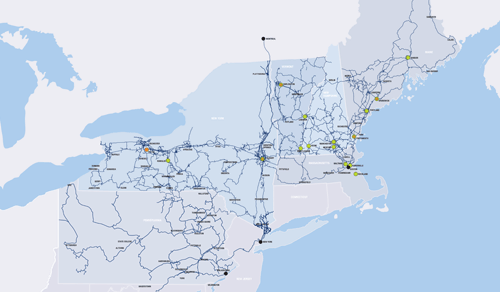In a surprisingly short amount of time, cloud computing has gone from being novel to commonplace. Today, almost every company uses cloud in some capacity. Even the general public has become familiar with the cloud through popular applications including Netflix and I-Tunes. As the cloud has gained acceptance, the ways of using it have evolved and expanded.
Cloud model preferences have changed, and companies are using the cloud to embrace other technology trends and lay the foundation for larger business strategies.
Here’s a more detailed look at 5 emerging cloud trends:
1) The Growing Popularity of Multicloud
 Instead of sticking with one cloud provider, many companies are turning to several vendors for multiple cloud models and services. 451 Research discovered that 69% of large companies plan to use a multicloud strategy by 2019.
Instead of sticking with one cloud provider, many companies are turning to several vendors for multiple cloud models and services. 451 Research discovered that 69% of large companies plan to use a multicloud strategy by 2019.
Multicloud allows organizations to choose cloud providers that specialize in particular services, such as infrastructure as a service (IaaS), platform as a service (PaaS), and software as a service (SaaS). A business might select one cloud provider to host an ERP system and another to host a CRM system or build an application development and testing environment.
2) Increased Public Cloud Adoption
For a long time, public cloud adoption growth rates were slower than those of the other cloud models. Companies have taken longer to warm up to public cloud because of security concerns. Organizations worried that sharing multi-tenant environments would open them up to risk. They also felt other users could negatively impact the quality of service they would receive.
Now companies are beginning to recognize the advantages of public cloud. The RightScale 2018 State of the Cloud Survey found that public cloud adoption rose from 89% in 2017 to 92% in 2018. Public cloud provides the ideal environment for public-facing applications. DevOps environments can be easily assembled and dismantled in the public cloud. IaaS in the public cloud also provides archiving, backup, and recovery resources.
3) Development of Cloud-First Strategies
 When companies adopt a cloud-first strategy, they consider whether every new project might be handled in the cloud. Organizations weigh the benefits the cloud offers over an on-premises solution. For many projects, the cloud brings time and cost savings because of its scalability and lack of capital expenses. Some companies that embrace a cloud-first approach may find themselves creating a cloud-only environment.
When companies adopt a cloud-first strategy, they consider whether every new project might be handled in the cloud. Organizations weigh the benefits the cloud offers over an on-premises solution. For many projects, the cloud brings time and cost savings because of its scalability and lack of capital expenses. Some companies that embrace a cloud-first approach may find themselves creating a cloud-only environment.
Back in 2011, the Obama administration established a cloud-first strategy for government that is just starting to bear fruit. Recently, the General Services Administration has been looking for qualified cloud providers to serve government agencies, and the Federal Risk and Authorization Management Program (FedRAMP) is working on developing language for its contracts with cloud vendors.
4) Using IoT With the Cloud
The internet of things (IoT) uses sensors on connected devices to track and monitor the status of business assets or supply chains. These sensors generate tons of data that can be processed to gain insights about inventory, operations, and maintenance. All this valuable data puts a strain on traditional infrastructures. That is where the cloud comes in.
The cloud provides a scalable infrastructure that can handle the massive influx of IoT data. Data can be stored in the cloud until it is processed by analytics applications. These analytics applications can be run on PaaS in the cloud.
5) Disaster Recovery as a Service (DRaaS)
 After last year’s devastating hurricane season, and the continued trend of human error and negligence as the cause for loss of most data, disaster recovery should be top of mind for all companies. However, small businesses are notorious for neglecting disaster recovery because of the expense. Cloud-based disaster recovery has emerged as a cost-effective solution.
After last year’s devastating hurricane season, and the continued trend of human error and negligence as the cause for loss of most data, disaster recovery should be top of mind for all companies. However, small businesses are notorious for neglecting disaster recovery because of the expense. Cloud-based disaster recovery has emerged as a cost-effective solution.
DRaaS provides enterprise-level disaster recovery without the expense of duplicating data center resources at a second physical site. A public cloud environment provides redundancy and instant failover. With a hybrid cloud environment, companies can synchronize public and private environments to ensure a rapid and full recovery after disaster strikes.
Getting On Trend With Cloud
Companies that have gotten on board with cloud may not have explored its full potential. The cloud means much more than scalable infrastructure. As our list of trends shows, the cloud empowers companies to do more with data and applications and to minimize risk.
FirstLight offers a wide variety of cloud services and solutions that enable your business to take advantage of today’s cloud trends, such as DRaaS. Our cloud offerings are connected to a high-speed fiber optic network that reduces latency. With our cloud solutions, your company retains control over your mission-critical data and applications while taking advantage of our fully supported and secure facilities.
Learn more about the latest cloud trends from leading IT experts at our upcoming Cloud Connect Summit at the University of Rochester’s Memorial Art Gallery on June 28th. Register here. Let FirstLight help you.




















